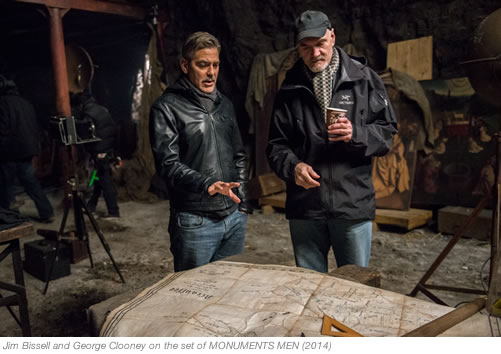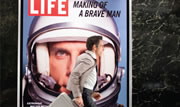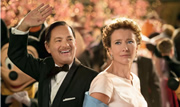
 THE MONUMENTS MEN production designer Jim Bissell is no stranger to collaboration on iconic films. Among the directors with whom he has worked are George Clooney, Steven Spielberg and Ridley Scott. With a film repertoire beloved by generations of movie-goers, Bissell, whose previous credits include E.T., THE EXTRA-TERRESTRIAL and 300, is a production design virtuoso. He may be best known for his collaboration with director George Clooney, starting with Clooney's feature film directorial debut, CONFESSIONS OF A DANGEROUS MIND and including GOOD NIGHT AND GOOD LUCK, LEATHERHEADS and THE MONUMENTS MEN, which opens nationwide on February 7. Their bond has shaped the film repertoire of America's new "it" director. Bissell's early experience in theatrical design at the University of North Carolina at Chapel Hill formed the basis of his design career. We sat down with the erudite designer in Studio City for a candid talk about the monumental undertaking of THE MONUMENTS MEN.
THE MONUMENTS MEN production designer Jim Bissell is no stranger to collaboration on iconic films. Among the directors with whom he has worked are George Clooney, Steven Spielberg and Ridley Scott. With a film repertoire beloved by generations of movie-goers, Bissell, whose previous credits include E.T., THE EXTRA-TERRESTRIAL and 300, is a production design virtuoso. He may be best known for his collaboration with director George Clooney, starting with Clooney's feature film directorial debut, CONFESSIONS OF A DANGEROUS MIND and including GOOD NIGHT AND GOOD LUCK, LEATHERHEADS and THE MONUMENTS MEN, which opens nationwide on February 7. Their bond has shaped the film repertoire of America's new "it" director. Bissell's early experience in theatrical design at the University of North Carolina at Chapel Hill formed the basis of his design career. We sat down with the erudite designer in Studio City for a candid talk about the monumental undertaking of THE MONUMENTS MEN.
 What is your design inspiration for THE MONUMENTS MEN? Have you ever read Anne Hollander? She teaches at Columbia. She's really amazing. She wrote a book called "Moving Pictures," which traces the origins of cinematic thought back to late renaissance in Northern European history. Amazing. Now if you read that book, and talk about gems – I mean, my God such an elegant, smart writer – she really knows about thematic imagery and story telling. You read that book, and then see this new movie.
What is your design inspiration for THE MONUMENTS MEN? Have you ever read Anne Hollander? She teaches at Columbia. She's really amazing. She wrote a book called "Moving Pictures," which traces the origins of cinematic thought back to late renaissance in Northern European history. Amazing. Now if you read that book, and talk about gems – I mean, my God such an elegant, smart writer – she really knows about thematic imagery and story telling. You read that book, and then see this new movie.
How do you initiate the process when you set out to design a new film? Henri Cartier-Bresson said, "I don't so much imagine the picture before I can take it, I see a place where a really good picture could occur and I wait." And that's sort of what a production designer does...to create that place where a really good picture is going to occur. And make sure you know what that picture is and what elements you need to be present at that nexus, at that spot, at that point in time, when the actors and the equipment and everybody shows up. You sort of know what it's going to be, but there's also an element of magic. And that's what's so exciting about it. It's so wonderful. You've got everything there, then you can concentrate on the magic. You conjure up the magic.
Why hasn't this story (THE MONUMENTS MEN) been told before? One of the reasons why is there is no central hero... Without a central character it's a very difficult story to tell. And one of the things that I think George is a master at is – and I think he showed his virtuosity at it in GOODNIGHT AND GOOD LUCK – is ensemble acting. He really works well with his actors. They like him; he likes them. So, if anybody can do it, it's him. And he took the 150, or however many monuments men there were, and condensed them down to sort of nine principal actors, and great actors. It was a fantastic cast.
What was the central message you wanted to create with your design work on THE MONUMENTS MEN? Essentially my job was to help [George] create an environment that showed number one – these guys didn't have to be there. They were dedicated and they were passionate about their mission. You had to show the kind of real jeopardy they placed themselves in order to fulfill that mission. You know, I'm 62. I'm not sure I would do what some of these guys did. I've got kids. Would I really risk my life to save European art? Over and over, risk my life?
 Was there any concern on your part to re-create 1000 years of culture? I always thought, in the very beginning, that was going to be the hardest part. It was the easiest part. For the most part, the works of art are beautifully documented digitally. So this was not hard with the paint crew we had, which was out of Studio Babelsberg. We printed out reproductions directly onto wood and then we did paint over those and then put a layer of the copper through just to make sure they had that kind of patina. It shot beautifully, except we had a couple of bubbling issues, but we actually solved that (smiles). The same thing for the Rembrandt self-portrait which is a featured piece of art. Those were not that difficult compared to the logistics of the rest of the stuff, obviously – if you're going to shoot and try to create the atmosphere that these guys were in, especially when they were on the front lines trying to confront field commanders and say "please don't shoot the tower off that beautiful church if you don't have to." Those kinds of scenes were extremely difficult because we wanted as much strain and jeopardy as we could bring into this situation. And obviously you know I've done 300 and...I know visual effects very well. You want as much real structure as you possibly can get.
Was there any concern on your part to re-create 1000 years of culture? I always thought, in the very beginning, that was going to be the hardest part. It was the easiest part. For the most part, the works of art are beautifully documented digitally. So this was not hard with the paint crew we had, which was out of Studio Babelsberg. We printed out reproductions directly onto wood and then we did paint over those and then put a layer of the copper through just to make sure they had that kind of patina. It shot beautifully, except we had a couple of bubbling issues, but we actually solved that (smiles). The same thing for the Rembrandt self-portrait which is a featured piece of art. Those were not that difficult compared to the logistics of the rest of the stuff, obviously – if you're going to shoot and try to create the atmosphere that these guys were in, especially when they were on the front lines trying to confront field commanders and say "please don't shoot the tower off that beautiful church if you don't have to." Those kinds of scenes were extremely difficult because we wanted as much strain and jeopardy as we could bring into this situation. And obviously you know I've done 300 and...I know visual effects very well. You want as much real structure as you possibly can get.
This marks your fourth collaboration with George Clooney. Can you describe that relationship? It's funny I've worked with some really great directors. And George is right up there. As a matter of fact, for this article [leans into the microphone] George Clooney is the best! You know, the press on him is right. He's a great guy. He's collaborative, but he's also a man of clear vision. So that is great, especially when you tackle something as ambitious as this project. It is not only a collaboration of what should it be about, but really agreeing on specific images that foretold and forwarded the story. It was like we had to just put together a strategy where we march through this in a very cost efficient way, but make sure that each image was really special.
Is there any pressure to making sure your sets are historically accurate? No, not if it feels right psychologically. You know, on a show like that with a 138 sets and locations, I can't cross every t and dot every i and make it historically accurate. I can't do it. It's impossible. But you have to make it right. In other words, if the scene is about what the guys are going through and about the context of their mission then that's what it's about. And you go through and you roll the images around in your head, you roll what the actors are going to be doing. You give them as many challenges to bring out their performance, what is important for the story, and that's what you create as a backdrop. That's what you create as an environment. That's what's important to have that sense of truth rather than the real truth.
 Writers have writer's block. Do you ever get designer's block? Oh yeah, yeah. And the funny thing is, when I do, that's when I draw on art – in a circumspect way, try to examine schematic material and see what else I can come up with. I use music a lot. I love music. I love classical music. I love very complex music. And that to me can sometimes shake it loose. And another thing that can always shake it loose is exercise. Go run. You know, go! I bike. I'm a mountain biker. If I just get out there and move my muscles sometimes it can break it loose. And then the third option is to write, to just constantly write. You know: What is it I like? What is it I don't like? And there's the other option: to sketch. I don't know what the image is. Just drawing lines on paper sometimes starts to form patterns that can give you an insight. It's a little like doing a crossword puzzle, and you don't know what it is, and you just stare at it for awhile and then you go, "Oh, that's what it is!" It just comes all at once.
Writers have writer's block. Do you ever get designer's block? Oh yeah, yeah. And the funny thing is, when I do, that's when I draw on art – in a circumspect way, try to examine schematic material and see what else I can come up with. I use music a lot. I love music. I love classical music. I love very complex music. And that to me can sometimes shake it loose. And another thing that can always shake it loose is exercise. Go run. You know, go! I bike. I'm a mountain biker. If I just get out there and move my muscles sometimes it can break it loose. And then the third option is to write, to just constantly write. You know: What is it I like? What is it I don't like? And there's the other option: to sketch. I don't know what the image is. Just drawing lines on paper sometimes starts to form patterns that can give you an insight. It's a little like doing a crossword puzzle, and you don't know what it is, and you just stare at it for awhile and then you go, "Oh, that's what it is!" It just comes all at once.
Do you have any advice for students starting out in production design? The key advice is: always study the masters. When the visual arts were at their inception, when there were no movies, there were people just as smart as us, probably smarter in many ways, who were telling stories with single images. Those were dense... with dramatic implication. You've got to study what they did because they thought about it a long time, because they put their life's effort into it, and they lived and died by the image.
How do you decide what productions to design for? It's just looking someone in the eye and saying, "I really love this story you're telling and I want to help tell it. I'll do anything I can do to help tell that story." Because that's what it's all about – it's about the story.
|
|
|
|
|




